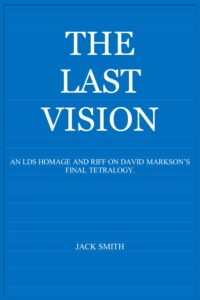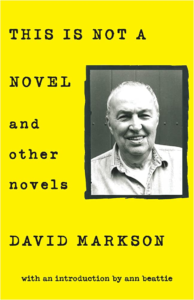 From Ships of Hagoth:
From Ships of Hagoth:
For our latest book-length message in a bottle, we present a greatly revised and expanded version of our experimental essay “Homage and Riff on David Markson’s Final Tetralogy” entitled The Last Vision, by Jack Smith.
The title of course is a portmanteau of Joseph Smith’s First Vision and David Markson’s Last Novel. Markson himself, the Jewish-American author most famous for his 1988 postmodern novel Wittgenstein’s Mistress, finished his life and career with a quartet of experimental novels—Reader’s Block (1996), This Is Not a Novel (2001), Vanishing Point (2004), and The Last Novel (2007)—that are each composed entirely of brief, non-sequitur anecdotes about famous authors and artists.
 Ships of Hagoth here presents an homage and riff on this singular tetralogy, one that is primarily LDS in theme and scope, for this is also a faith singularly obsessed with the question of how much can be cut away entirely, which is arguably everything, “For all things must fail—”
Ships of Hagoth here presents an homage and riff on this singular tetralogy, one that is primarily LDS in theme and scope, for this is also a faith singularly obsessed with the question of how much can be cut away entirely, which is arguably everything, “For all things must fail—”
Jack Smith is an obvious pseudonym, as vague and generic and Everyman as the name of Brother Joseph himself, and he would like to keep it that way.
The Last Vision is available on AMAZON in ebook and in paperback formats.
Here is a selection from the first four pages of the book:
David Markson, most famous for his 1988 postmodern novel Wittgenstein’s Mistress, finished his life and career with a quartet of experimental novels (1996’s Reader’s Block, 2001’s This Is Not a Novel, 2004’s Vanishing Point, and 2007’s The Last Novel) that are each composed entirely of brief, non-sequitur anecdotes about famous authors and artists.
Joseph Smith, Jr. was born in 1805 just after the winter solstice and killed in 1844 just after the summer solstice.
Brigham Young sent a group of LDS artists on a mission to Paris, specifically to learn how to paint the murals within the endowment rooms of the Salt Lake Temple.
Provo-native Avard Tennyson Fairbanks was the youngest student ever admitted into the École nationale supérieure des beaux-arts in Paris, in 1913. He produced sculptures commissioned by both the Church and the U.S. Supreme Court, among others.
Minerva Tichert was the first woman invited to paint a mural for an LDS Temple—specifically, the World Room in the Manti Temple.
Online mass-protests had to be organized to save the Pioneer- era art preserved within the Manti Temple during the 2021 renovations.
The murals inside the Salt Lake Temple were torn down and destroyed during the 2019 renovations.
As of this writing, the first Google hit for The Book of Mormon is tickets to the satirical Southpark Broadway musical.
Markson refers to this style as his “personal genre. In which part of the experiment is to continue keeping him offstage to the greatest extent possible—while compelling the attentive reader to perhaps catch his breath when things achieve an ending nonetheless.”
Jimmy Eat World’s first bassist quit to serve a mission—just before they hit it big with “The Middle.”
The first bassist for Panic! at the Disco was also LDS.
Parley P. Pratt’s satirical short-story, “Joe Smith and the Devil,” generally credited as the first work of Mormon fiction, was first published by the New York Herald in 1844—the same year as Smith’s murder.
Joseph Smith wrote a long-poem version of D&C 76, in rhyming quadrants.
Lorenzo Snow’s “As man is now, God once was/As God is now, man may become,” being probably the most widely quoted couplet in the Church.
RLDS president Joseph Smith III wrote poetry—often about the melancholic absence of his father.
Orson F. Whitney’s scolding response-poem to William Ernest Henley’s Invictus.
If Eliza R. Snow hadn’t written “O My Father,” would we still have a doctrine of Heavenly Mother preserved in popular memory?
The steady accumulation of these various anecdotes in Markson’s final four novels slowly begin to form a narratively-suggestive portrait of the author’s own frustrated state-of-mind.
Bruce R. McConkie reportedly told congregations that if a bomb went off in the building, odds are most everyone there would receive their exaltation.
Mark Hoffman set off a car bomb to cover up his Salamander Letter forgeries in 1985.
The King Follet discourse is the only Joseph Smith sermon to be regularly anthologized in collections of famous U.S. sermons; but because it was delivered off-the-cuff, there remains no scholarly agreement about any of the original wording to this day.
Joseph Smith’s third-grade education—cited as evidence by both his enemies and his adherents.
His great-grand-nephew Joseph Fielding Smith edited and compiled Teachings of the Prophet Joseph Smith–and corrected all the spelling errors.
